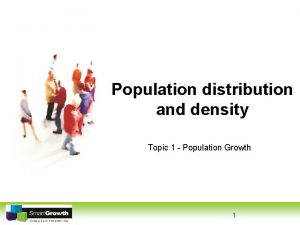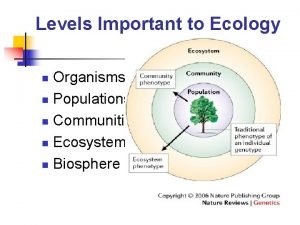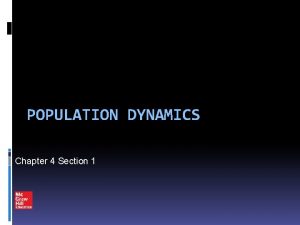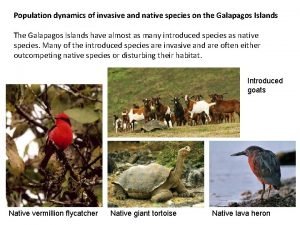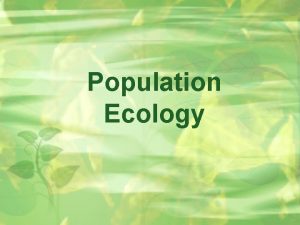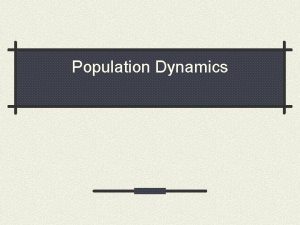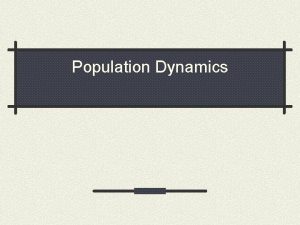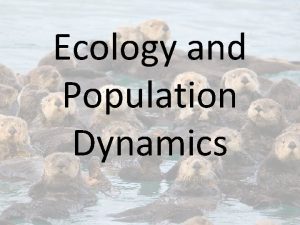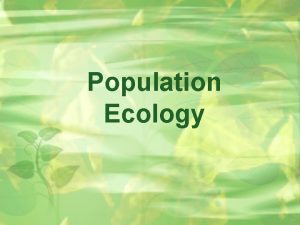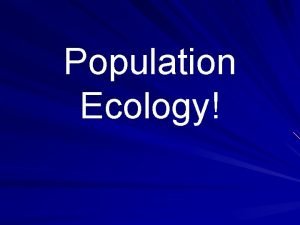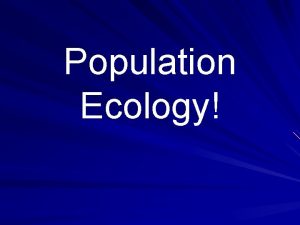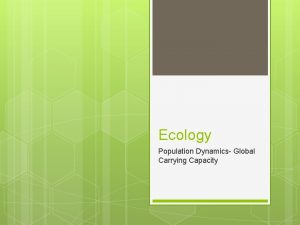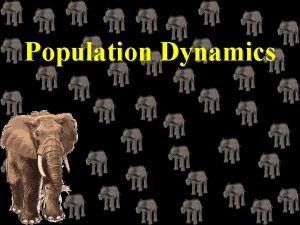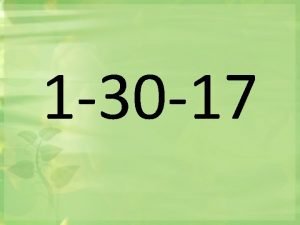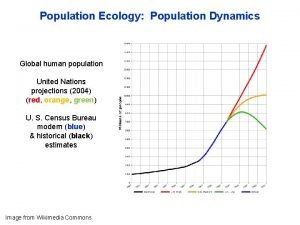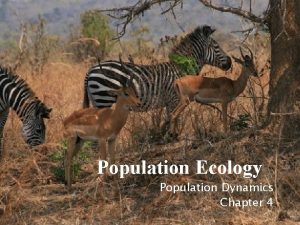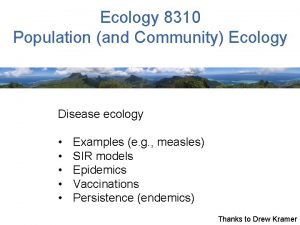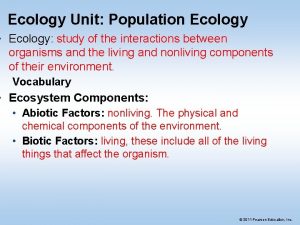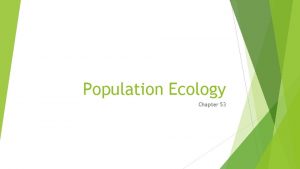Population Ecology Population Dynamics Population All the individuals
























- Slides: 24

Population Ecology

Population Dynamics Population: All the individuals of a species that live together in an area

Population Dynamics Three Key Features of Populations Size Density Dispersion

Three Key Features of Populations #1 - Size: number of individuals in an area

Three Key Features of Populations #2 - Density: measurement of population per unit area or unit volume Pop. Density = # of individuals ÷ unit of space

How Do You Affect Density? 1. Immigration: movement of individuals into a population 2. Emigration: movement of individuals out of a population 3. Density-dependent factors: Biotic factors in the environment that have an increasing effect as population size increases (disease, competition, parasites) 4. Density-independent factors: Abiotic factors in the environment that affect populations regardless of their density (temperature, weather)

Factors That Affect Future Population Growth Immigration Natality + + Population Emigration - Mortality

Density-Dependent Factors limiting resources (e. g. , food & shelter) production infectious of toxic wastes diseases predation stress emigration

Density-Independent Factors severe storms and flooding sudden unpredictable severe cold spells earthquakes and volcanoes catastrophic meteorite impacts

A graphic way of representing population data is a survivorship curve. This is a plot of the number of individuals still alive at each age. A Type I curve shows a low death rate early in life (humans). The Type II curve shows constant mortality (squirrels). Type III curve shows a high death rate early in life (oysters).

Survivorship Curve

Three Key Features of Populations #3 - Dispersion: describes the spacing of organisms relative to each other Clumped Uniform Random

Population Dispersion

How Are Populations Measured? Population density = number of individuals in a given area or volume Count all the individuals in a population Estimate by sampling Mark-Recapture Method

How Do Populations Grow? Idealized models describe two kinds of population growth: 1. Exponential Growth 2. Logistic Growth

Exponential Growth Curve Figure 35. 3 A

Logistic Growth Curve

Carrying Capacity (k): The maximum population size that can be supported by the available resources There can only be as many organisms as the environmental resources can support

Factors Limiting Growth Rate Declining birth rate or increasing death rate are caused by several factors including: Limited The food supply buildup of toxic wastes Increased Predation disease

How well does the logistic model fit the growth of real populations? The growth of laboratory populations of some animals fits the S-shaped curves fairly well. Stable population Seasonal increase

Some of the assumptions built into the logistic model do not apply to all populations. It is a model which provides a basis from which we can compare real populations. Severe Environmental Impact

“Booms” and “Busts”

Reproductive Strategies R § § § Strategists Short life span Small body size Reproduce quickly Have many young Little parental care Ex: fish, cockroaches, weeds, bacteria

Reproductive Strategies • K Strategists § Long life span § Large body size § Reproduce slowly § Have few young § Provides parental care § Ex: humans, elephants, orcas
 Section 1 population dynamics answer key
Section 1 population dynamics answer key Section 1 population dynamics answer key
Section 1 population dynamics answer key Population ecology section 1 population dynamics
Population ecology section 1 population dynamics Population ecology section 1 population dynamics
Population ecology section 1 population dynamics Population ecology example
Population ecology example Exponential growth equation ecology
Exponential growth equation ecology Population vs community ecology
Population vs community ecology Population vs community ecology
Population vs community ecology Concept 3 population ecology
Concept 3 population ecology Chapter 53 population ecology
Chapter 53 population ecology Equilibrial life history
Equilibrial life history Chapter 4 population ecology answer key
Chapter 4 population ecology answer key Ecology def
Ecology def Chapter 53 population ecology
Chapter 53 population ecology What is uniform dispersion
What is uniform dispersion Chapter 4 section 1 population dynamics answer key
Chapter 4 section 1 population dynamics answer key Population characteristics ecology
Population characteristics ecology What is population ecology
What is population ecology Population definition ecology
Population definition ecology Population ecology
Population ecology Parasitism
Parasitism Chapter 53 population ecology
Chapter 53 population ecology Name
Name Study guide chapter 4 section 1 population dynamics
Study guide chapter 4 section 1 population dynamics Galapagos
Galapagos



















